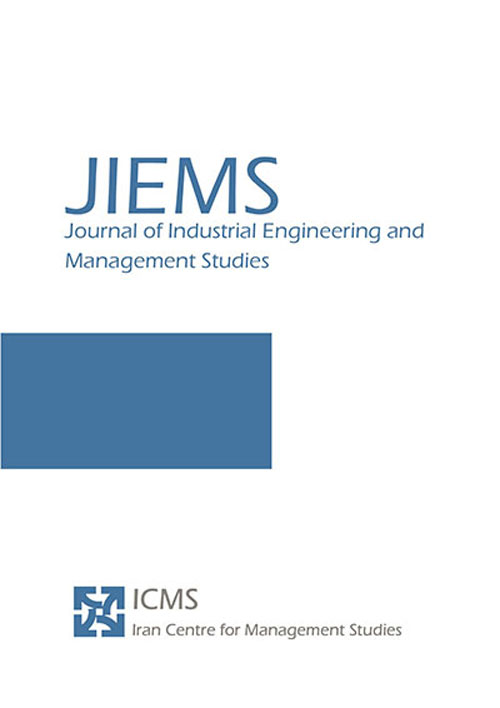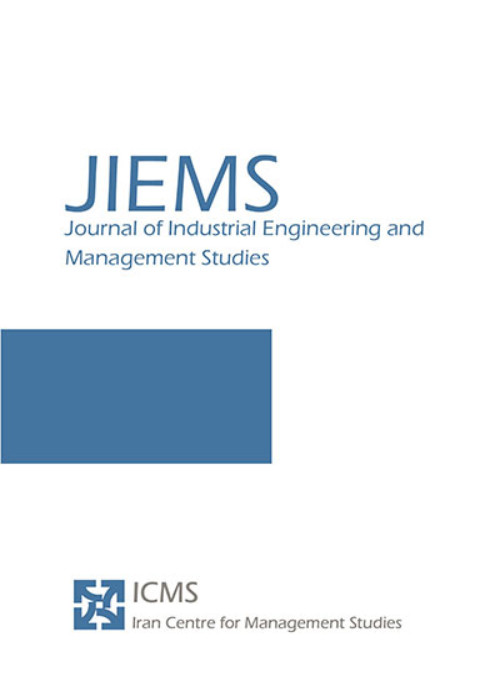فهرست مطالب

Journal of Industrial Engineering and Management Studies
Volume:4 Issue: 2, Summer-Autumn 2017
- تاریخ انتشار: 1396/10/15
- تعداد عناوین: 6
-
-
Pages 1-18This study considers a reliable location inventory problem for a supply chain system comprising one supplier, multiple distribution centers (DCs), and multiple retailers in which we determine DCs location, inventory replenishment decisions and assignment retailers to DCs, simultaneously. Each DC is managed through a continuous review (S, Q) inventory policy. For tackling real world conditions, we consider the risk of probabilistic distribution center disruptions, and also uncertain demand and lead times, which follow Poisson and Exponential distributions, respectively. A new mathematical formulation is proposed and we model the proposed problem in two steps, in the first step, a queuing system is applied to calculate mean inventory and mean reorder rate of steady-state condition for each DC. Next, regarding the results obtained from the first step, we formulate a mixed integer nonlinear programming model which minimizes the total expected cost of inventory, location and transportation and can be solved efficiently by means of LINGO software. Finally, several test problems and sensitivity analysis of key parameters are conducted in order to illustrate the effectiveness of the proposed model.Keywords: inventory – location model_Disruption_queueing theory_uncertain demand_Supply Chain Management
-
Pages 19-34The CCC-r chart is developed based on cumulative count of a conforming (CCC) control chart that considers the cumulative number of items inspected until observing r nonconforming ones. Typically, the samples obtained from the process are analyzed through 100% inspection to exploit the CCC-r chart. However, considering the inspection cost and time would limit its implementation. In this paper, we investigate the performance of CCC-r chart with variable sampling interval (CCC-rVSI chart). The efficiency of CCC-rVSI chart is compared with fixed sampling interval (FSI) scheme of CCC-r chart (CCC-rFSI chart) and CCCVSI chart. The comparison results show that CCC-rVSI chart is more efficient than the CCCVSI chart in reducing the average time to signal (ATS) and also CCC-rVSI chart performs better than CCC-rFSI chart. In addition, some sensitivity analyses are performed to illustrate the effect of the input parameters on the performance of CCC-rVSI chart.Keywords: Attribute control chart, variable sampling interval, CCC, r chart, average time to signal
-
Pages 35-51This paper includes a simulation model built in order to predict the performance indicessuch aswaiting time by analyzing queues components in the real world under uncertain and subjective situation. The objective of this paper is to predict the waiting time of each customer in an M/M/C queuing model. In this regard, to enable decision makers to obtain useful results with enough knowledge on the behavior of system, the queuing system is considered in fuzzy environment in which the arrival and service times are represented by fuzzy variables. The proposed approach for vague systems can represent the system more accurately, and more information is provided for designing queueing systems in real life. Furthermore, simulation method is applied successfully for modeling complex systems and understanding queuing behavior. Finally, a numerical example as a case study in a banking system is solved to show the validity of developed model in the real situation.Keywords: Queuing Theory, Fuzzy set, M, M, C model, Simulation, Uncertainty
-
Pages 52-63Precedence constrained sequencing problem (PCSP) is related to locate the optimal sequence with the shortest traveling time among all feasible sequences. In PCSP, precedence relations determine sequence of traveling between any two nodes. Various methods and algorithms for effectively solving the PCSP have been suggested. In this paper we propose a cuckoo search algorithm (CSA) for effectively solving PCSP. CSA is inspired by the life of a bird named cuckoo. As basic CSA at first was introduced to solve continuous optimization problem, in this paper to find the optimal sequence of the PCSP, some schemes are proposed with modifications in operators of the basic CSA to solve discrete precedence constrained sequencing problem. To evaluate the performance of proposed algorithm, several instances with different sizes from the literature are tested in this paper. Computational results show the good performance of the proposed algorithm in comparison with the best results of the literature.Keywords: Precedence constrained sequencing problem, Mixed integer programming, Cuckoo search algorithm
-
Pages 64-84Railway scheduling is a complex task of rail operators that involves the generation of a conflict-free train timetable. This paper presents a discrete-event simulation-based optimization approach for solving the train timetabling problem to minimize total weighted unplanned stop time in a hybrid single and double track railway networks. The designed simulation model is used as a platform for generating feasible conflict-free train timetables. It includes detailed infrastructure information, such as station characteristics, trains running time and praying intervals. The proposed approach has the capability of scheduling trains in large-scale networks subject to the capacity constraints and infrastructure characteristics. In optimization procedure, a path relinking meta-heuristic algorithm is utilized to generate near-optimal train timetables. A case study of Iran railway network is selected for examining the efficiency of the meta-heuristic algorithm. The computational result shows that the proposed approach has the capability of generating near-optimal timetable in real-sized train scheduling problems.Keywords: Train scheduling, Simulation, based optimization, Object oriented model, evolutionary path re, linking
-
Pages 85-102The present study attempts to establish a new framework to speculate customer lifetime value by a stochastic approach. In this research the customer lifetime value is considered as combination of customers present and future value. At first step of our desired model, it is essential to define customer groups based on their behavior similarities, and in second step a mechanism to count current value, and at the end estimate the future value of customers. Having a structure in modeling customer churn is also important to have complete customer lifetime value computation. Clustering as one of data mining techniques is practiced to help us analyze the different groups of customers, and extract mathematical model to count the customers value. Thereafter by using Markov chain model as stochastic approach, we predict future behavior of the customer and as a result, estimate future value of different customers. The proposed model is demonstrated by the customer demographic data and historical transaction data in a composite manufacturing company in Iran.Keywords: Customer Lifetime Value, Markov Chain Model, clustering, Classification, Customer Behavior


